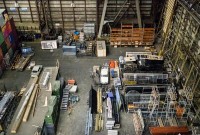- Home
- Business Processes
- Industry Knowledge
- Aerospace Industry
- Automotive Industry
- Banking Domain
- BFSI Industry
- Consumer/ FMCG Industry
- Chemicals Industry
- Engineering & Construction
- Energy Industry
- Education Domain
- Finance Domain
- Hospitality Domain
- Healthcare Industry
- Insurance Domain
- Retail Industry
- Travel and Tourism Domain
- Telecom Industry
- Leadership Skills
- eLearning
- Home
- Functional
- Order to Cash
- Miscellaneous Warehouse Processes
Miscellaneous Warehouse Processes
At the end of each inventory control, the Contractor provides the Ordering Person with an inventory report which contains a list of all stock adjustments. The Ordering Person uses the report to create, by use of his/her own means, necessary value and accounting adjustments related to the stock. Let us look at some to the mislaneous warehouse processes not covered earlier.
Let us look at some to the mislaneous warehouse processes not covered earlier.
- At the end of each inventory control, the Contractor provides the Ordering Person with an inventory report which contains a list of all stock adjustments. The Ordering Person uses the report to create, by use of his/her own means, necessary value and accounting adjustments related to the stock.
- Management of Source Documents (Sales orders, returns, transfer orders, production orders, and kanban)
- Location stocking limits
- Location volume Metrics
- Inventory Status
- Batch and serial item support
- Item receiving capabilities
- Multiple picking strategies
- Barcode scanners
- Pallet/container types
- Advanced counting capabilities
- Label printing and label routing
- Business intelligence
- Movement of inventory
- Quality Control
- Outbound wave processing
- Manual packing
- Containerization support
- Cluster picking
- Simple cross docking
- Production order
- Kanban
- Pick operation
- Put operation
- Transferring inventory from one location to another
- Work Pools: Work pools are used to organize work into groups. For example, you can create a work pool to classify work that occurs in a particular warehouse location.
- Staging Area
- Location Directives: Location directives are used to direct the work transactions to the appropriate locations in the warehouse. They define where to pick and put.
- FEFO Batch Reservation Strategy
- Outbound Sales Picking
- Advanced shipment notice (ASN)
- Item Velocity: The velocity code of a product is a measure of its movement in the supply chain. Products are classified as having a velocity code A, B, or C. Velocity code A indicates fast moving items and C indicates slow moving items. The speed at which an item moves varies by regions, seasons, and other parameters. For example, during winter, snow jackets can sell more on the east coast of the US than on the west coast.
- Product Items: A product item is a physical unit that can be ordered, shipped, and returned. A product item is uniquely defined by its item ID and unit of measure. You can configure items, units of measure, master catalogs, categories, classifications, and additional item attributes.
- SKU: In the field of inventory management, a stock keeping unit (SKU) is a distinct type of item for sale and has attributes associated with it that distinguish it from other item types. For a product, these attributes can include manufacturer, description, material, size, color, packaging, and warranty terms. SKU can also refer to a unique identifier or code, sometimes represented via a barcode for scanning and tracking, that refers to the particular stock keeping unit. These identifiers are not regulated or standardized.
- Preparation: Preparation is one of the warehouse operations performed to prepare a product for sale. Businesses often sell their products in sets. Such a set may consist of goods from different manufacturers, which arrived at the warehouse as different deliveries. Preparation is creating a set (a new “product”) from a number of different, single products. It allows businesses to put a set in the cart, rather than several individual products. The warehouse is able to complete such an order more quickly as it has sets ready to be released.
- Goods Insurance: Warehouse Insurance offers comprehensive coverage for losses arising due to damage to warehouse building, the goods stored in it or the machinery stored in it. It also offers coverage for the loss of profits arising out of the damage. The warehouse and all the goods stored should be insured to their full value at all times as a best practice. Someone should be assigned to manage for all formalities related to the insurance of the warehouse and goods.
- Warehouse Entry Process: All visits should be authorized and should be conducted only in the presence of the Warehouse Manager/Authorized person. Visits should not interfere with the regular operations of the warehouse. All visitors should comply with the safety procedures applicable at the warehouse, with all health and safety regulations related to visiting the warehouse, and with all instructions given by the Warehouse Manager etc.
- Turnaround time: Efficiency of a warehouse depends on how quickly it deals with delivery vehicles. Turnaround time for warehouse is the time taken between a vehicle arriving and departing. This is important because transport operators get paid for having their vehicles moving, and want to minimize the idle time during loading or unloading.
Related Links
You May Also Like
-
Overview of Third-Party Logistics
Third-party logistics (abbreviated as 3PL, or TPL) is an organization's use of third-party businesses to outsource elements of its distribution, warehousing, and fulfillment services. A third-party logistics provider (3PL) is an asset-based or non-asset based company that manages one or more logistics processes or operations (typically, transportation or warehousing) for another company.
-
One of the warehousing best practices that retailers like Walmart, Amazon, and Target have adopted is known as cross-docking. During this process the inbound products are unloaded at a distribution center and then sorted by destination, and eventually reloaded onto outbound trucks. In real parlance, the goods are not at all warehoused but just moved across the dock (hence the name).
-
Warehouses can be places where piles of packed or loose products occupy space. If left disorganized, it will become very challenging to identify products for packing or picking. Hence, proper organization of warehouse is very important. Warehouse labeling systems eliminate this problem by making sure products are easily identified and managed during the warehousing and shipping process. Labeling is the most functional and cost-effective way to keep your warehouse organized and operating efficiently.
-
One of the most important decisions when running a warehouse is its layout. Warehouse layout defines the physical arrangement of storage racks, loading and unloading areas, equipment and other facility areas in the warehouse. A good layout aligned with the business needs could have a significant effect on the efficiency.
-
Business Case of Multiple Warehouses
Adding extra warehouses to business provides many benefits such as reducing shipping costs, increasing storage capacity, and having warehouses for specific purposes to simplify overall warehouse management. Multiple warehouses allow you to organize your inventory in a way that helps your business be more effective.
-
When a customer wants a product that has been stored in the warehouse, the same need to be picked off the shelf (or off the floor) and get it ready for shipping. Depending on how big is the warehouse, picking can take a while. (Many distribution centers cover more than 1 million square feet.). Hence, warehouse order picking methods are an important aspect within any warehouse.
-
Resource Planning is the process of planning for expected workload and determining the number of resources required to complete each activity in the warehouse. There are many types of warehouse positions, and they also vary by the employer, the scale of operations and location. Discussed here are generic positions applicable to warehouse management processes.
-
Before shipping, businesses need to make sure that the items will arrive in good condition. Packaging is a form of protection against environmental threats that the product will face from the time it leaves warehouse facility until the time it reached the customer. The packaging is intended to provide protection for the item as it is being handled in the warehouse or when the item is being shipped.
-
Warehouses may seem like a simple, straightforward concept, but they actually include a variety of different types of warehouses that all have their own niche. The type of warehousing that’s right for you depends on your specific industry, location, and needs. From private warehousing, distribution centers, and climate-controlled warehouses, there’s an option to suit every business.
-
Inventory is money, and hence businesses need to perform physical inventory counts periodically to make sure that their inventory records are accurate. The traditional approach to conducting inventory counts is to shut down a facility during a slow time of year to count everything, one item at a time. This process is slow, expensive, and (unfortunately) not very accurate.
Explore Our Free Training Articles or
Sign Up to Start With Our eLearning Courses

About Us
Learning
© 2023 TechnoFunc, All Rights Reserved










